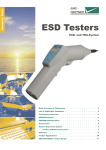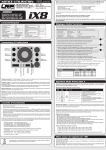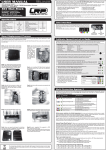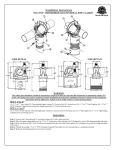Download Pulsar LA00011 User's Manual
Transcript
LA00011 Dear Customer, By purchasing the Pulsar Competition Charger (called PCC) you have selected one of the most advanced battery- and motor-management systems. Through the use of the latest digital technology, the product achieves very high performance and reliability. The following features give the PCC decisive benefits (see later for detailed description): • Intuitive, logical navigation • Blue backlit LC display with 2x16 characters • Autostart timer from 0 to 99 mins • 3 professional devices in one (charge, discharge, motor run-in) • Storage for user-defined programs • Multiprotection system (triple protection + integrated fan) USER GUIDE Order No.: 41550 LRP electronic Wilhelm-Enssle-Str. 132-134, 73630 Remshalden, Germany Tel.: int+49-71 81-40 98-0, Fax: int+49-71 81-40 98-30 WWW.LRP-ELECTRONIC.DE ! • Digital microprocessor-controlled with PCS-2 and auto-restart system • PWM circuit for efficient charging under all conditions Don’t forget to read the complete instructions for use carefully before you start to operate the PCC. Make sure you have understood all the points. TECHNICAL DATA Dimensions Weight Input voltage Charge type No. of cells Charge current Trickle current Delta peak PCS-2 Autostart timer 100x153x70 mm 600 g 11 to 15 V linear & flex 1 to 8 0.1 to 8.0 A 0.0 to 0.4 A 5 to 80 mV yes 0 to 99 mins Discharge current 10 A Cut-off voltage 3.6 - 6.0 V Motor run-in function 2.0 to 7.2 V Matching yes Auto restart-system yes Multiprotection system 3-way LC display blue backlit, 2x16 LED blue Keys 4 Integrated, program-controlled fan yes WARNING NOTES • Only use the PCC to charge quick-chargeable nickel-cadmium or nickel-metalhydride-battery packs. If you try to charge other cell types (e.g. lead, lithium-ion, etc.), it may cause damage to the cells or the PCC. • Avoid any contact of your PCC with water or other liquids. • Never cover the cooling slots on the PCC. Only place your PCC on constanttemperature surfaces. Never place on carpets or cloths. • Never allow the PCC to operate without supervision and never keep your PCC connected to a power supply, car battery or battery pack when it is not in use. • Only charge serially switched battery packs containing 1 to 8 cells. Never charge parallel switched cells. SPECIAL FEATURES PCS-2 (Peak Capacity System): The voltage charge curve of NiMH cells may vary considerably at the start of charging due to cell construction. Conventional chargers interpret this incorrectly as delta peak reached and terminate the charging process (false peak). The PCC includes the LRP-exclusive PCS-2 which contains advanced algorithms to detect this phenomenon: This ensures reliable full charging. PCS-2 allows the perfect full charge of all cell types by means of an adjustable delta peak and high-precision digital-filter detection of all parameters throughout the entire charging process. The PCC signals full charge and end of charge by an alert buzzer that sounds for 4 minutes at 3-second intervals. • Always comply with the charging instructions of the battery manufacturers and matchers and never exceed their specifications (refer to the additional sheet for adjustment tips). • Never use a power supply with more than 15 V output voltage. Never try to operate the PCC directly from a 110/230 VAC power source! For best performance, we recommend the LRP Powersupply (#43150). • Make sure you connect the terminals with the correct poalrity, on both the input and output sides! Red indicates the positive pole and black the negative pole. • New chargers may produce a slight odor in the first few hours of service due to materials curing inside the device. • If individual cells in the pack heat up excessively, immediately stop the charging process. TERMINALS/DISPLAY/OPERATION The PCC was developed with the main objective placed on easy operation of all features. Intuitive navigation by means of 4 keys makes it very easy to use and the 2-line LC display offers perfect, reliable control of all parameters. Input MENU DEC - Auto Restart System: LED As a worldwide innovation, the PCC continues to charge after the input voltage fails and displays the duration of the power failure if it last longer than 3 mins. A total power failure at races is no rarity and this feature allows you to fully charge your battery packs within the remaining time at increased charge current. The PCC keeps you informed of the length of the charge interruption. Example: “Int14min“ (for 14 min interruption) is displayed in alternating sequence. INC + START/STOP Output Changing the current during a charge: The charge current can be changed during a charge by pressing INC+ or DEC- without interrupting the process. This change in not stored. The next time you start charging, the device takes the data settings stored under “Settings”. Refer to PCS-2. PWM Circuit: The PCC ensures efficient charging through the use of the latest digital technology. There are many benefits here: a) maximum charge current even at low input voltage b) maxium charge current already for 1-to 4-cell battery packs c) very low heat dissipation d) more charges out of a car battery since the charger has a higher efficiency Autostart Timer: This handy feature lets you preselect when you want to start the PCC for a charge session; adjustable from 0 to 99 mins. Keys: MENU DEC INC + START/STOP Scrolls / jumps through the function list Decrements the underscored value.* Increments the underscored value.* Next program step / Start a program / Cancel a running program * Key has high-speed function for rapid setting (hold down key to change value faster). SETTINGS Displays: Active function Charge current Time elapsed since start The PCC is supplied with factory settings which you can customize in the Main menu under “Settings”. The values you change under “Settings” are stored automatically. You can compose your personal charge profile which you can retrieve at any time. To reset your PCC to factory settings, proceed as follows: • Disconnect input voltage • Hold down MENU key while reconnecting the input voltage. Battery or motor icon Voltage at output connectors Capacity PROGRAM STRUCTURE MATCHING This fully automatic matching program allows you to determine the actual performance of your packs before using them. Battery packs change during their life span. Use the PCC to detect the actual quality of your packs. This prevents nasty surprises. The “Matching” feature uses the values stored under “Settings”. The pack is first discharged, then charged and finally discharged. At the end of the process, the pack capacity and the average discharge voltage are displayed. TROUBLESHOOTING GUIDE The PCC is protected against faults and operator errors by the Multiprotection System. Faults are displayed on the LCD. Some faults may interrupt the charging session. Display CHARGE SET Charge Current: The charge current can be set variably from 0.1 A to 8.0 A. If not otherwise specified by the battery manufacturer, the quick charge current should be max. twice the nominal capacity for Sub-C cells typically used in model-making. SET Trickle Current: This current, which flows after delta peak cutoff, is adjustable from 0.0 A to 0.4 A to achieve the highest possible voltage for NiCd cells. Set this function to Off for NiMH cells. SET Charge Mode: The PCC comprises two charging processes. 1. “Linear” = charge at constant charge current. Usual process for competition batteries. 2. “Flex” = charge current is interrupted by short discharge pulses. Optimizes the crystalline structure of the cell interior and hikes performance for older and less used packs. Possible Cause: Wrong battery polarity Short-circuit at output Battery defect No contact to battery Input voltage too low No input voltage Connector on PS/car battery gone No. of cells on discharge > 7 Response... Operation interrupted after 4 s warning buzzer (returns to Main menu). Resumes automatically when input voltage restored Interrupted after 4 s warning buzzer (returns to Main menu). Current consumption of motor is > 9.5 A Interrupted after 4 s warning buzzer Armature shorted (returns to Main menu). No contact to motor LCD: LCD stays dark, no function change the fuse Fan: Fan is program-controlled and only runs when necessary. If fan still doesn’t run, there is no fault. Input Low: If input voltage too low, the PCC will continue to charge and set the charge current automatically to make sure full battery charge is achieved. If this function is active, “Inp Low” appears in the LCD alternating with the input voltage reading. You cannot increase the charge current manually. Fuse: The PCC has an additional internal fuse which protects the charger from irreparable damage if operated incorrectly! The PCC is supplied with a replacement fuse. It is easy to replace. Proceed as follows: Make sure that nothing is connected to the PCC. Slacken two screws in the housing base and fold open the housing. Remove the defective fuse. Insert a new fuse and then close the PCC. SET D-Peak (delta peak): You only obtain the best battery full charge if you “overload” the battery slightly. In practice, it isn’t overcharged but at optimum full charge. The battery voltage drops at the end of the charging process (delta). The size of the drop (delta peak) is adjustable in the range from 5 mV to 80 mV. The higher the value, the hotter the battery will be at charge end. We recommend you start with the factory setting of 20 mV. DISCHARGE The 10 A discharge circuit of the PCC was specially developed to discharge 6- and 7-cell battery packs since these are the numbers of cells used in competition. 4- and 5-cell battery packs can also be discharged. However, in this case, the discharge current is smaller. The PCC informs you about all the data relating to the battery pack, e.g. discharge time, capacity and average voltage. By discharging your battery pack on the PCC after use, you obtain vital information about residual capacity for the next time you use your motor or change gear ratio. This also maintains your battery packs in good order. For best maintenance, we recommend the use of LRP Discharger #41350. SET Discharge Voltage: The cut-off voltage can vary from 3.6 V to 6 V depending on the number of cells. We recommend a cutoff of 0.9 V per cell. This means 3.6 V for a 4-cell pack, or 5.4 V for a 6-cell pack. 1 YEAR FULL WARRANTY (ONLY VALID FOR GERMANY, AUSTRIA AND SWITZERLAND) LRP electronic grants 1 year full warranty on the Pulsar Competition Charger from the date of purchase. Your dealer is entitled to replace the charger after verification of the cash receipt and a simple visual inspection. Before you make a claim concerning this product, please check all the other components on your model and refer to the Troubleshotting Guide to exclude other fault sources. The only restrictions we make are for gross operator errors such as water damage, mechanical damage, improper tampering inside the device, cut wires, incorrect connection to mains or voltage overload. In these cases, your dealer will offer you a partial warranty. You will receive a replacement charger free of charge despite the product defect, but you will have to pay for the operator errors as listed below. You can also return the defective product directly to LRP. This applies both to the warranty claims, operator errors and defects which occur outside the warranty period. If you have a warranty claim, you must send in the cash receipt and a description of the defect. We hope you will appreciate that, in this case, our engineers must test the returned product to make sure that an operator error was not the cause for the defect. Outlay lumpsum costs for operator error within warranty period: • No or damaged power cord approx. 18.• Water in housing, water damage approx. 36.• Solder on PCB approx. 36.- • Housing damaged approx. 20.• PCB/components damaged approx. 23.Repair prices plus statutory VAT Maximum repair costs for operator error are 50% of original purchase price. MOTOR RUN-IN You can use this function in a number of ways, e.g.: • Running in the motor or motor brushes (check for excess current consumption). • Powering com-lathes • Powering 7.2 V soldering irons The voltage setting (you can change this during operation), current and operating time are displayed. SET Motor Run-In Voltage: The voltage is continuously variable from 2.0 V to 7.2 V. We recommend a voltage of 4.0 V for running in motor brushes. The special run-up electronics allow trouble-free running-in of motors with very high no-load currents and low number of turns when you set the charger to low voltages. LRP products are manufactured to extremely stringent quality criteria. Since we cannot supervise the proper use of our products, we can accept no liability for direct or indirect damage of any type arising from their use or occurring to the property of the user and/or third parties. Therefore, any use of this product shall take place at the user’s own risk. The warranty claim may not exceed the value of this product in any case. By putting this product into operation you accept the above conditions and assume full responsibility for the use of this product. Defects outside of warranty period: Defective products can also be returned to your dealer or directly to LRP electronic for repair or replacement outside of the warranty period. General warranty conditions: The figures specified by LRP electronic concerning weight, size, charge current or other are intended as guidance values only. LRP electronic can accept no formal liability for such specifications as different values may result from technical changes made to the product in the interests of technical progress.









